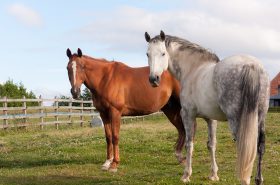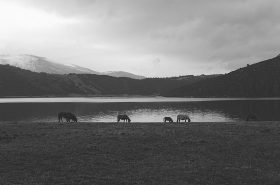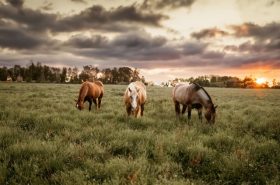Some of these horse myths may really shock you!
Sometimes it can be hard to differentiate facts from myths in the horse world. Some statements have been around for generations. You’ve grown accustomed to hearing them. You mother, grandfather, riding instructor, etc.. have said it so many times why would you ever question it. The reality is there’s a lot of myths circulating around. It’s time to clear them up!
Watch out for these common myths!
-
All horses need shoes.
The reality is ‘shoes or barefoot’ isn’t a simple question. Some horses need shoes for medical reasons, while others compete in disciplines that make them a necessity. On the other hand, many do just fine barefoot. Those that enjoy trail riding can even purchase boots for rocky terrain. It’s important you don’t put all horses in the same category- some need shoes, some are great barefoot! Let the horse’s hooves do the talking.
-
Your horse only needs hay!
Those that feed a high-quality forage are heading in the right direction. Hay, grass, and other forages are an essential part of your horse’s diet. However, you horse also has vitamin and mineral requirements that need to be met. Some of these include vitamin E, iron, manganese, and more. You don’t necessarily have to turn to a grain to satisfy these though. Many horse owners utilize supplements, ration balancers, and salt licks. The biggest factor is centering your horse’s diet around their lifestyle and filling in any gaps.
-
Black hooves are stronger than white hooves.
Scientific research has successfully disproved this myth! So please… don’t pass up a horse just because he has white hooves. The structure of hooves are similar in both colors. If you want to compare strength, then look at the horse’s diet, exercise, farrier schedule, and bloodlines. These have way more influence than color!

-
Hot and cold-blooded horses have different body temperatures.
Nope, whoever created this myth needs to open a science book. All mammals, including horses, are warm-blooded. Whether it’s hot or cold outside, horses (and all mammals) maintain a rather level body temperature.
Many riders are referring to a horse’s personality and temperament when they describe them as cold or hot-blooded. A hot horse is usually energetic and spirited, while a cold one has a calm, mellow demeanor. It has nothing to do with their internal temperature.
-
Your horse can succeed in any discipline.
Unfortunately, that’s not the case for most horses. You can try and even have fun learning a new discipline, but that doesn’t mean your horse will succeed or win ribbons in it. Certain bloodlines and breeds are known for exceling in particular disciplines. If you’re looking to reach a high level, then make sure to really evaluate the horse’s potential.

-
Don’t ever walk behind a horse.
This advice may be helpful for beginners, but it doesn’t always apply to experienced horse people. No matter what your level, caution should be exercised when walking behind and in front of your horse. They can kick and bite! In many cases, you might need to go behind your horse though. Some examples include long lining, driving, braiding their tail, and even getting to their other side.
-
Your horse can’t see in color.
False! They have dichromatic vision, also known as two-color. It’s suspected that horses can see blue and yellow, but no intermediate colors. For comparison, people can see four basic colors and almost 100 intermediate shades. Your horse is likely to see white, gray, and desaturated tones of blue and yellow. Rest assure they do see more than black and white though!
Some of these myths might have shocked you! So, before you spread or create another one, make sure to do your homework. Let’s only spread facts!
**
Emily Fought discovered her passion for horses early on in life. When she isn’t writing about them, you can find her in the barn riding. Although Emily’s background is in dressage, she enjoys cross-training and is an avid trail rider. She resides in Northwestern Pennsylvania with her husband and small dog. Together, they own and operate Humblewood Farm.



